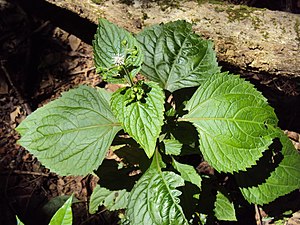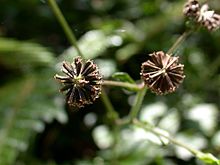Coloring spot flower
| Coloring spot flower | ||||||||||||
|---|---|---|---|---|---|---|---|---|---|---|---|---|

Coloring spot flower ( Adenostemma lavenia ) |
||||||||||||
| Systematics | ||||||||||||
|
||||||||||||
| Scientific name | ||||||||||||
| Adenostemma lavenia | ||||||||||||
| ( L. ) Kuntze |
The coloring spotted flower ( Adenostemma lavenia ) is a species of the genus Adenostemma within the sunflower family (Asteraceae). It is a dye and medicinal plant .
description
Adenostemma lavenia is a very variable species.
Appearance and leaf
Adenostemma lavenia grows as an annual herbaceous plant and reaches heights of 0.3 to 1 meter. Usually only an upright, stiff to almost prostrate stem is formed, which is sparsely branched in the upper area and sparsely hairy with white hair, and in the lower area bare.
The foliage leaves, which are arranged opposite each other on the stem, are relatively far away from each other, the smaller they are the further up they are on the stem and are divided into a petiole and a leaf blade. The petiole is 1 to 6 cm long and winged (0.5 to 4 cm). The simple leaf blade is narrow-egg-shaped, egg-shaped or triangular with a length of 1 to 20 cm and a width of 1 to 13 cm or also with a length of 4 to 12 and a width of 2 to 5 cm elliptical-lanceolate, elliptical to rhombic elliptical, broadly ovate to heart-shaped with a pointed to blunt upper end. The base of the blades is wide to narrow wedge-shaped. The upper and lower sides are usually sparsely haired and the hair can decrease with age. The trichomes are usually very densely arranged along the leaf veins . The leaf margins are notched or cut, single or double serrated. The upper and lower leaves are smaller and also shorter in stalk than the middle ones. The basal leaves can wither or persist after the flowering period.
Inflorescence and flower
The flowering time is in Australia from spring to early summer and in China from August to October. In loose or dense, umbrella-clustered or paniculate overall inflorescences, there are usually a few, rarely many, cup-shaped partial inflorescences above slender, gray-white or rust-colored and 0.8 to 3 cm long inflorescence shafts. The hemispherical involucre has a diameter of 4 to 5 × 6 to 8 mm during flowering and up to 10 mm during fruiting. The bracts are and more or less bare. The almost identically shaped bracts are arranged in two rows and are green, with a length of 3 to 4 mm narrow-oblong to narrow-elliptical, rounded, bent back, thin and almost membranous. The outer bracts are mostly fused and hairy sparsely white shaggy and have a blunt upper end.
There are only tubular flowers . The tubular flowers are white and have glandular hairs. The corolla tube ends in five coronet teeth. The five approximately 2.5 cm long, tubular fused petals have sticky glands and are downy hairy.
fruit
The achenes , which are blackish-brown when ripe, are 2 to 4 mm long and about 1 mm wide and are obverse-lanceolate and triangular with a narrowed base and blunt upper end. The surface of the achenes is glandular and more or less densely warty. In China, the achenes ripen from August to October.
The pappus consists of three to five club-shaped pappus bristles with a length of about 1 to 4 mm, which are fused at their base to form a reddish-yellow, sticky-glandular ring.
Chromosome number
The number of chromosomes is 2n = 20.
Occurrence
Its Asian distribution area extends from India and Nepal through China (Anhui, Fujian, Gansu, Guangdong, Guangxi, Guizhou, Hainan, Henan, Hubei, Hunan, Jiangsu, Jiangxi, Nanhai Zhudao, Shaanxi, Sichuan, Xizang, Yunnan, Zhejiang) and Taiwan to Korea , Thailand and the Philippines . It is probably widespread in Southeast Asia . In Australia, Adenostemma lavenia occurs in the states of New South Wales , Queensland and Northern Territory ; in the state of New South Wales mainly in Bulahdelah, but there are also older reports from Botany Bay . It occurs in Hawaii .
In China, Adenostemma lavenia thrives on banks, roadsides, forest edges, bushes on slopes at altitudes between 400 and 2300 meters. In New South Wales grows in damp, shady places.
Systematics
The extent of the species Adenostemma lavenia is handled differently: while the "Flora of China" assumes a species that is widespread in Southeast Asia, other authors only refer to the plants occurring in Sri Lanka as Adenostemma lavenia and separate the species Adenostemma tinctorium and Adenostemma in the rest of Southeast Asia viscosum .
From adenostemma lavenia there are at least three varieties:
- Adenostemma lavenia var. Latifolium (D. Don) Handel-Mazzetti
- Adenostemma lavenia (L.) Kuntze var. Lavenia
- Adenostemma lavenia var. Parviflorum (Blume) Hochreutiner
use
To dye
Adenostemma lavenia is used for dyeing in shades of blue.
medicine
Adenostemma lavenia is also used medicinally, for example the subspecies Adenostemma lavenia var. Latifolium in skin diseases.
swell
- Yilin Chen, Takayuki Kawahara & DJ Nicholas Hind: Tribus Eupatorieae : Adenostemma lavenia , p. 881 - online with the same text as the printed work , In: Wu Zheng-Yi, Peter H. Raven & Deyuan Hong (editors): Flora of China , Volume 20 –21 - Asteraceae , Science Press and Missouri Botanical Garden Press, Beijing and St. Louis, November 12, 2011. ISBN 978-1-935641-07-0 (Description and Occurrence section)
Individual evidence
- ↑ a b Info from sagebud.com .
- ↑ a b c d e f g h i j k l m n o p q r s t u v w x y Yilin Chen, Takayuki Kawahara & DJ Nicholas Hind: Tribus Eupatorieae : Adenostemma lavenia , p. 881 - same text online and printed Work , In: Wu Zheng-Yi, Peter H. Raven & Deyuan Hong (editors): Flora of China , Volume 20–21 - Asteraceae , Science Press and Missouri Botanical Garden Press, Beijing and St. Louis, November 12, 2011. ISBN 978-1-935641-07-0
- ↑ a b c d e f g h i j k l m MF Porteners: Adenostemma lavenia (L.) Kuntze at New South Wales Flora Online .
- ↑ List of coloring plants, Adenostemma lavenia in first place (PDF; 28 kB)

